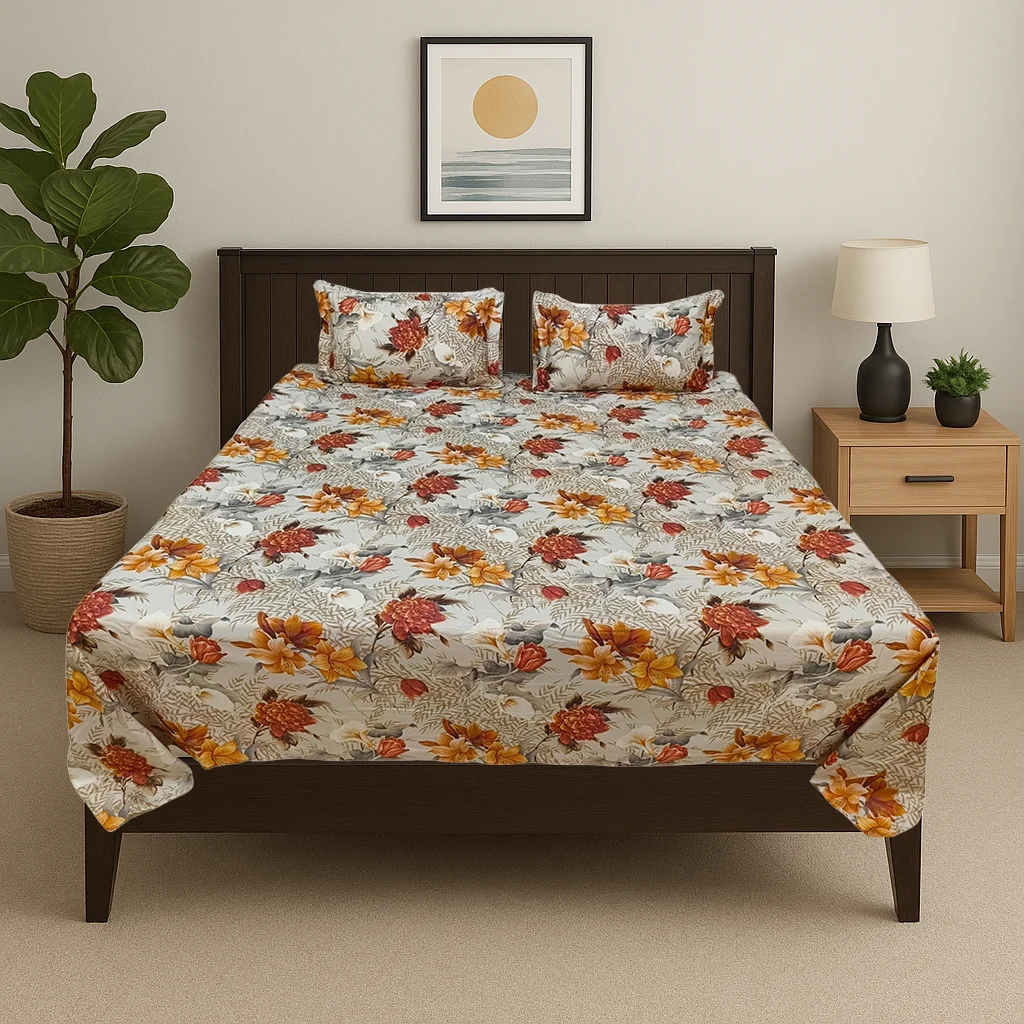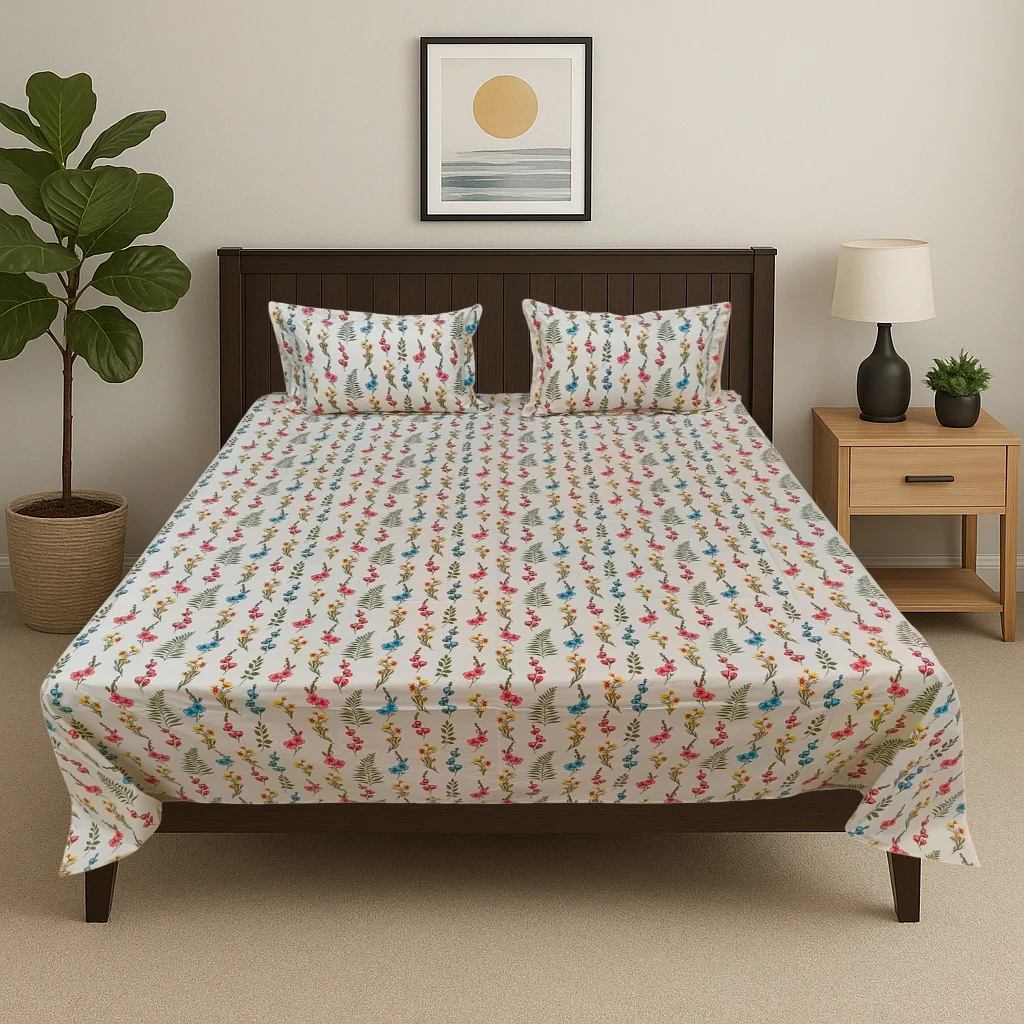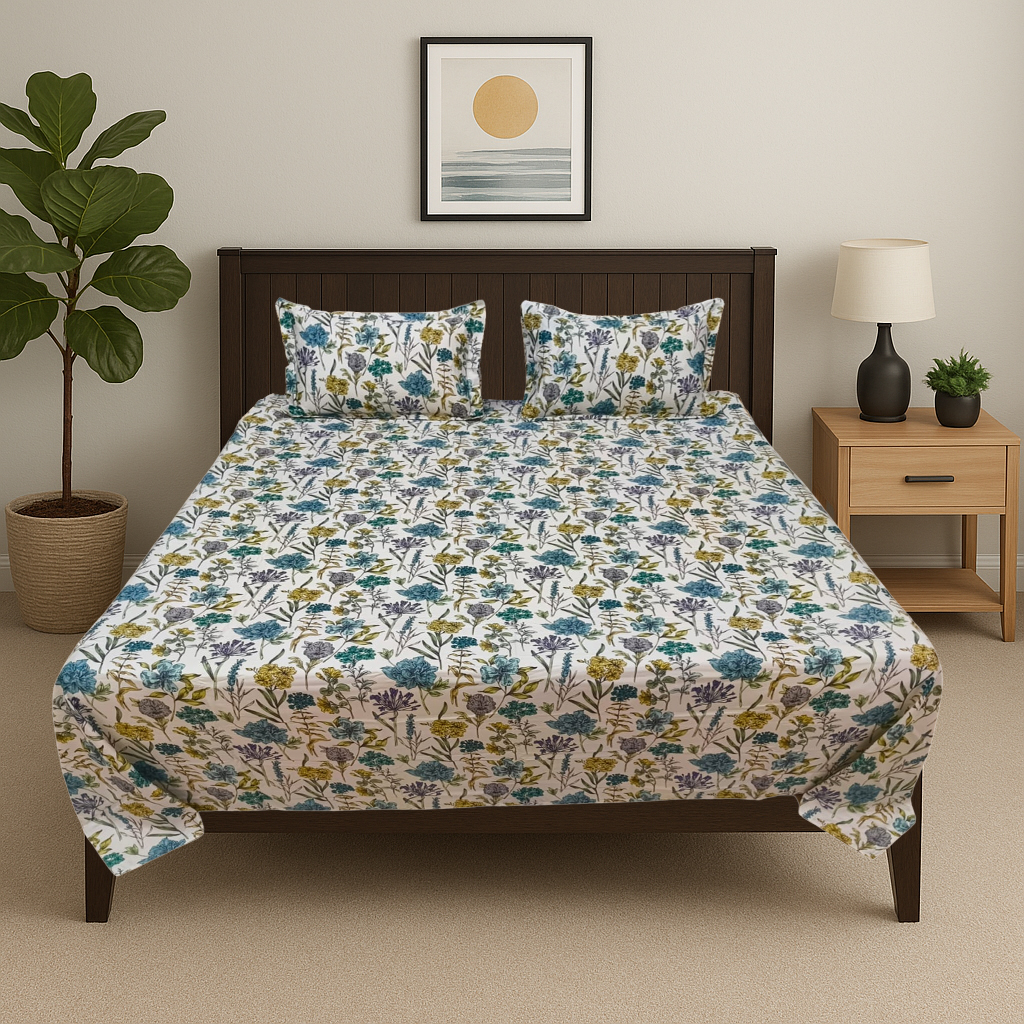
Your complete guide to selecting bedsheets that combine comfort, quality, and style – backed by 40+ years of textile expertise
Quick Answer: How Do You Choose the Perfect Bedsheet Set?
The perfect bedsheet set combines three key elements: optimal thread count (200-400 for cotton), fabric type matching your sleep preferences and climate, plus design that complements your bedroom style. Quality trumps quantity – focus on single-ply cotton construction, appropriate weave (percale for cooling, sateen for luxury), and trusted manufacturing over inflated thread count claims. Consider your sleeping temperature, maintenance preferences, and aesthetic goals. Price ranges from ₹1,500-₹8,000 for quality sets in India.
The Complete Framework for Bedsheet Selection
Choosing bedsheets shouldn’t feel overwhelming, yet with hundreds of options promising everything from “hotel luxury” to “1000+ thread count,” the decision can be paralyzing. This comprehensive guide cuts through marketing noise to reveal what actually matters for quality, comfort, and value.
The Three Pillars of Perfect Bedsheet Selection:
- Thread Count Reality – Understanding what numbers actually mean
- Fabric Science – Matching materials to your needs
- Design Psychology – Creating your ideal sleep environment
Let’s explore each pillar in detail to help you make the best choice for your bedroom.
Part 1: Thread Count Demystified – Beyond the Marketing Hype

Understanding Thread Count Fundamentals
Thread count refers to the number of threads woven into one square inch of fabric, including both horizontal (weft) and vertical (warp) threads. While often used as a quality indicator, thread count is just one factor – and not always the most important one.
How Thread Count Actually Works:
- Warp Threads: Run vertically (up and down)
- Weft Threads: Run horizontally (side to side)
- Total Count: Sum of both directions per square inch
- Example: 150 warp + 150 weft = 300 thread count
The Truth About “Optimal” Thread Count
The Sweet Spot: 200-400 Thread Count
Single-ply cotton sheets with thread count between 200-400 are ideal for bedding, as sheets above or below this range tend to feel thicker or rougher. Here’s why this range works best:
200-300 Thread Count:
- Excellent breathability and airflow
- Durable and long-lasting
- Perfect for hot climates and warm sleepers
- Cost-effective without sacrificing quality
300-400 Thread Count:
- Balanced softness and breathability
- Luxurious feel without excessive weight
- Suitable for most sleep preferences
- Good value for premium comfort
400+ Thread Count:
- May not change much beyond the price tag, and can sometimes stifle airflow resulting in heavier, warmer feel
- Often more expensive with minimal comfort benefit
- Can trap heat, unsuitable for warm sleepers
Thread Count Manipulation Tactics to Avoid
Red Flags That Signal Inflated Numbers:
Multi-Ply Manipulation: Manufacturers count every single ply when calculating thread count – a 2-ply, 200 thread count sheet is actually only 100 individual threads. This explains why supposedly higher thread count sheets sometimes feel inferior.
Warning Signs:
- Thread counts above 600 at unusually low prices
- Vague descriptions without single-ply specifications
- Absence of material composition details
- Claims like “luxury thread count” without specifics
What to Look For Instead:
- Single-ply confirmation in product descriptions
- Long-staple cotton specifications (when choosing cotton)
- Transparent manufacturing details
- Thread count within 200-400 range for optimal performance
Part 2: Fabric Science – Choosing Your Perfect Material
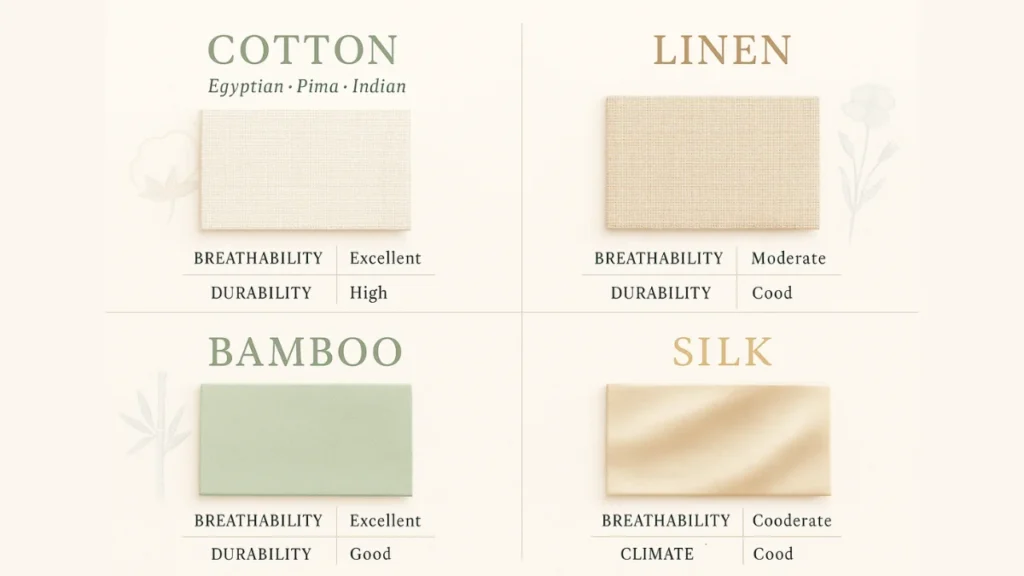
Cotton: The Classic Choice
Cotton remains the most popular material for sheet sets, being breathable and easy to wash, making it a good option for warm sleepers. But not all cotton is created equal.
Types of Cotton (Quality Hierarchy):
1. Egyptian Cotton (Premium)
- Characteristics: Extra-long staple fibers, luxurious softness
- Thread Count Range: 300-800 optimal
- Best For: Ultimate luxury, special occasions
- Price: ₹4,000-₹12,000+
- Considerations: Higher cost, requires careful sourcing verification
2. Pima/Supima Cotton (High Quality)
- Characteristics: Long-staple American cotton, durable and soft
- Thread Count Range: 200-400 optimal
- Best For: Premium comfort with reliability
- Price: ₹3,000-₹8,000
- Considerations: Excellent value for premium quality
3. Indian Long-Staple Cotton (Excellent Value)
- Characteristics: Climate-adapted, authentic craftsmanship
- Thread Count Range: 200-350 optimal
- Best For: Quality with cultural authenticity
- Price: ₹2,000-₹5,000
- Considerations: Best value, supports local textile heritage
4. Regular Cotton (Standard)
- Characteristics: Short to medium staple, basic comfort
- Thread Count Range: 180-250 optimal
- Best For: Budget-conscious buyers, guest rooms
- Price: ₹800-₹2,500
- Considerations: Lower durability, may feel coarser
Linen: The Breathable Luxury
Linen sheets are soft, breathable, and even more absorbent than cotton, with fibers that give superior strength and make it crisper than cotton.
Linen Advantages:
- Breathability: Even more breathable than cotton because fibers are more hollow, allowing air to flow through more easily
- Durability: Considered one of the most durable fibers in the world
- Temperature Regulation: Excellent for hot climates and warm sleepers
- Aging: Gets softer and more comfortable over time
- Eco-Friendly: Sustainable flax plant cultivation
Linen Considerations:
- Initial Texture: Can feel stiff initially, softens with use
- Wrinkle-Prone: Natural wrinkling is part of the aesthetic
- Price: Generally more expensive than cotton
- Care: May require more attention to maintain appearance
Best For:
- Hot sleepers and humid climates
- Those who love natural, relaxed aesthetics
- Long-term investment buyers
- Eco-conscious consumers
Bamboo: The Sustainable Innovation
Bamboo fabric is softer than cotton and has been compared to silk or cashmere, with sheets that are durable, lightweight, and absorbent.
Bamboo Processing Types:
1. Bamboo Viscose/Rayon (Most Common)
- Feel: Silky, smooth, luxurious
- Properties: Temperature-regulating, moisture-wicking
- Price: ₹2,500-₹6,000
- Considerations: Chemical processing involved
2. Bamboo Linen (Rare)
- Feel: More textured, similar to cotton linen
- Properties: Chemical-free processing
- Price: Higher than viscose
- Considerations: Coarser texture, more sustainable
Bamboo Advantages:
- Softness: Temperature-regulating and moisture-wicking properties
- Hypoallergenic: Natural antimicrobial properties
- Sustainability: Fast-growing, renewable resource
- Comfort: Cool to touch, ideal for hot sleepers
Best For:
- Those with sensitive skin
- Hot sleepers seeking silk-like comfort
- Eco-conscious buyers
- People who prefer smooth textures
Silk: The Ultimate Luxury
Silk sheets are known for being anti-friction, making them great for anyone worried about hair breakage, plus they’re hypoallergenic and temperature-regulating.
Silk Quality Measurements:
- Momme Count: 19-25 momme for quality sheets
- Mulberry vs. Wild: Mulberry silk is premium standard
- Grade: A-grade silk for best quality
Silk Advantages:
- Temperature Regulation: Cool in summer, warm in winter
- Hair and Skin Benefits: Reduces friction and breakage
- Hypoallergenic: Natural protein fibers
- Luxury Feel: Unmatched smoothness and sheen
Silk Considerations:
- Price: Most expensive option (₹8,000-₹25,000+)
- Care: Requires special detergents, gentle handling
- Durability: More delicate than cotton or linen
- Slippery: May be too smooth for some preferences
Synthetic Options: Budget-Friendly Alternatives
Microfiber:
- Pros: Affordable, wrinkle-resistant, easy care
- Cons: Less breathable than cotton, may not be best choice for those with sensitive skin
- Best For: Budget buyers, easy maintenance
Polyester Blends:
- Pros: Durable, color retention, lower cost
- Cons: Less breathable, may trap heat
- Best For: High-usage situations, children’s bedding
Part 3: Weave Types – The Hidden Quality Factor
The way threads are woven together significantly impacts how sheets feel, breathe, and perform.
Percale Weave: The Cool and Crisp Option
Construction: One thread over, one thread under pattern, creating crisp, lightweight fabric with matte finish
Characteristics:
- Feel: Crisp, cool, hotel-like
- Breathability: Excellent airflow
- Appearance: Matte finish, casual elegance
- Durability: Very strong, improves with washing
Perfect For:
- Hot sleepers and warm climates
- Those who prefer hotel-style crispness
- Summer bedding in most Indian cities
- People who like to flip pillows to the cool side
Sateen Weave: The Smooth and Lustrous Choice
Construction: Three or four threads over, one thread under, creating silky fabric with lustrous sheen
Characteristics:
- Feel: Silky, smooth, luxurious
- Breathability: Good but less than percale
- Appearance: Subtle sheen, elegant drape
- Durability: Slightly less than percale, may pill
Perfect For:
- Those seeking silky smoothness
- Cooler climates or air-conditioned rooms
- Formal bedroom aesthetics
- People who prioritize lustrous appearance
Twill Weave: The Durable Alternative
Construction: Diagonal parallel ribs creating textured appearance
Characteristics:
- Feel: Textured, substantial
- Breathability: Moderate
- Appearance: Subtle diagonal pattern
- Durability: Excellent, very long-lasting
Perfect For:
- High-use applications
- Those prioritizing durability
- Casual, relaxed bedroom styles
- Families with children or pets
Part 4: Size Selection – Getting the Perfect Fit
Understanding Indian Bed Sizes
Standard Indian Measurements:
Single Bed (3′ x 6’6″):
- Flat Sheet: 60″ x 90″ minimum
- Fitted Sheet: 36″ x 78″ + depth allowance
- Common Use: Children’s rooms, hostels, guest rooms
Double Bed (4’6″ x 6’6″):
- Flat Sheet: 85″ x 100″ minimum
- Fitted Sheet: 54″ x 78″ + depth allowance
- Common Use: Master bedrooms, standard couples
Queen Size (5′ x 6’6″):
- Flat Sheet: 90″ x 100″ minimum
- Fitted Sheet: 60″ x 78″ + depth allowance
- Common Use: Modern homes, premium accommodation
King Size (6′ x 6’6″):
- Flat Sheet: 105″ x 100″ minimum
- Fitted Sheet: 72″ x 78″ + depth allowance
- Common Use: Luxury suites, spacious master bedrooms
Mattress Depth Considerations
Measuring Your Mattress:
- Measure Height: From base to top surface
- Add Allowance: 2-4 inches for secure fit
- Consider Toppers: Include mattress pad thickness
Depth Categories:
- Standard: 6-8 inches (most common in India)
- Thick: 8-12 inches (premium mattresses)
- Extra Thick: 12+ inches (luxury, pillow-top)
Fitted Sheet Depths:
- Regular: 8-10 inch depth accommodation
- Deep Pocket: 12-15 inch depth accommodation
- Extra Deep: 16+ inch depth accommodation
Part 5: Design and Color Psychology
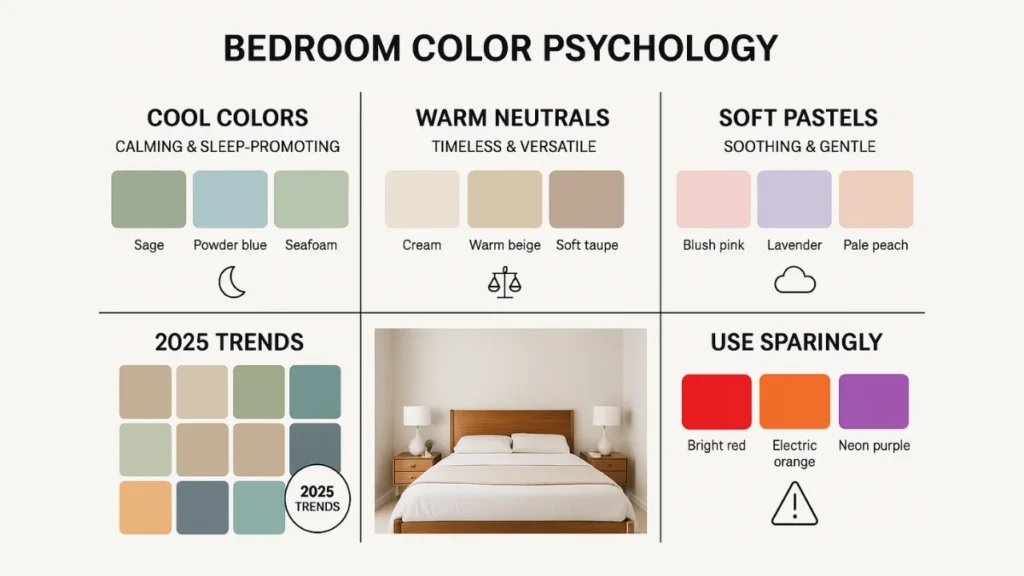
Color Selection for Better Sleep
Colors can significantly impact mood and sleep quality, with certain hues promoting relaxation while others may be energizing.
Colors That Promote Sleep:
Cool Blues and Greens:
- Effect: Calming, reduce heart rate
- Best For: Stress relief, better sleep quality
- Trending: Deep sapphire and forest green gaining popularity for cozy, intimate feel
Soft Neutrals:
- Effect: Peaceful, versatile
- Best For: Easy coordination, timeless appeal
- Popular: Beige, taupe, and soft greys remain timeless favorites for sophisticated atmosphere
Gentle Pastels:
- Effect: Soothing, non-stimulating
- Best For: Creating serene environment
- Trending: Lavender, light yellow, blush pink, and baby blue for fresh, airy feel
Colors to Use Carefully:
Bright Reds and Oranges:
- Can be too stimulating for sleep
- Better as accent colors rather than dominant bedding
- May increase energy rather than promote rest
Pure White:
- Starting to look sterile in 2025, especially when paired with brighter duvets
- Consider soft alternatives like cream or pale mint
- Works well as one element in layered bedding
Pattern Selection for Personality
2025 Pattern Trends:
Florals: Making a comeback with both vintage-inspired and minimalist botanical designs
- Small Florals: Easier to coordinate, less overwhelming
- Large Florals: Bold statement, needs careful balance
- Best For: Adding femininity and natural beauty
Geometric Patterns: Abstract designs and geometric shapes making statement in 2025
- Simple Geometrics: Modern, sophisticated
- Complex Patterns: Can be visually busy, use sparingly
- Best For: Contemporary, minimalist spaces
Stripes: The pattern of 2025 for mix of classic and modern
- Thin Stripes: Subtle, sophisticated
- Wide Stripes: Bold, dramatic
- Best For: Creating visual interest without overwhelm
Gingham: Charming, classic pattern everywhere in 2025 for effortless, nostalgic feel
- Small Check: Subtle, versatile
- Large Check: Statement making
- Best For: Cottagecore, farmhouse aesthetics
Design Coordination Tips
Creating Cohesive Bedroom Style:
Monochromatic Approach:
- Choose one color family
- Use different shades and textures
- Add interest through fabric variation
Complementary Colors:
- Use color wheel opposites
- Balance bold with neutral
- Maintain 60-30-10 rule (dominant-secondary-accent)
Pattern Mixing Rules:
- Scale Variation: Mix large and small patterns
- Color Consistency: Share at least one common color
- Pattern Types: Combine different pattern styles (floral + geometric)
Part 6: Seasonal Considerations for Indian Climate
Summer Bedding Strategy (March-June)
Fabric Priorities:
- Cotton Percale: Maximum breathability
- Linen: Superior heat management
- Bamboo: Moisture-wicking properties
- Thread Count: 200-300 for airflow
Color Recommendations:
- Light colors to reflect heat
- Cool blues and greens for psychological cooling
- Avoid dark colors that absorb heat
Design Features:
- Minimal layering
- Lightweight construction
- Easy-wash fabrics for frequent cleaning
Monsoon Bedding Strategy (June-September)
Fabric Priorities:
- Quick-Dry Materials: Bamboo, synthetic blends
- Antimicrobial Properties: Bamboo, treated cotton
- Humidity Resistance: Avoid pure linen (slow drying)
Practical Considerations:
- Easy machine washing and drying
- Stain-resistant treatments
- Multiple sets for frequent changes
Winter Bedding Strategy (October-February)
Fabric Priorities:
- Sateen Weaves: Heat retention properties
- Flannel: Brushed cotton for warmth
- Higher Thread Count: 350-400 for density
Color Psychology:
- Warmer colors (burgundy, deep green)
- Richer, more saturated tones
- Cozy patterns and textures
Layering Strategy:
- Heavier base sheets
- Additional blanket compatibility
- Texture variation for interest
Part 7: Quality Assessment – Spotting Premium Construction

Physical Quality Indicators
Touch Test Standards:
- Premium Feel: Smooth without being slippery
- Appropriate Weight: Substantial but not heavy
- Even Texture: Consistent throughout fabric
- Natural Drape: Falls gracefully, not stiff
Visual Inspection Checklist:
- Color Consistency: Even dye distribution
- Stitching Quality: Straight, reinforced seams
- Pattern Alignment: Proper matching at connections
- Fabric Grain: Straight weave, not skewed
Manufacturing Quality Markers
Certification Standards to Look For:
- OEKO-TEX Standard 100: Chemical safety testing
- GOTS (Global Organic Textile Standard): Organic certification
- Better Cotton Initiative: Sustainable cotton sourcing
- ISO Certifications: Quality management systems
Construction Details:
- Hem Quality: Double-fold hems, proper finishing
- Seam Reinforcement: Stress points properly secured
- Label Information: Complete care and composition details
- Packaging: Professional presentation, protective wrapping
Red Flags to Avoid
Quality Warning Signs:
- Strong chemical odors indicating poor processing
- Uneven coloring or streaky appearance
- Loose threads or visible construction flaws
- Extremely lightweight for claimed specifications
Retailer Red Flags:
- No return or exchange policy
- Missing material composition information
- Absence of care instruction labels
- Vague or missing manufacturer details
Part 8: Budget Planning and Value Assessment
Understanding Price-Quality Relationship
Budget Segment (₹800-₹2,000):
- What You Get: Basic cotton blends, simple designs
- Thread Count: 150-200 typically
- Best For: Guest rooms, temporary housing, children’s bedding
- Limitations: Lower durability, may feel coarser
Mid-Range Segment (₹2,000-₹4,000):
- What You Get: 100% cotton, decent thread count, variety
- Thread Count: 200-300 optimal range
- Best For: Daily use, growing families, value seekers
- Benefits: Good balance of quality and affordability
Premium Segment (₹4,000-₹8,000):
- What You Get: Long-staple cotton, superior finishing, design authenticity
- Thread Count: 300-400 with quality construction
- Best For: Long-term investment, comfort priority, special occasions
- Benefits: Enhanced durability, superior comfort, style leadership
Luxury Segment (₹8,000+):
- What You Get: Egyptian cotton, silk, premium linen, artisan craftsmanship
- Thread Count: Quality over quantity focus
- Best For: Ultimate comfort, gift giving, luxury experience
- Benefits: Maximum durability, exceptional comfort, prestige
Cost-Per-Use Analysis
Calculating True Value:
- Initial Investment: Purchase price
- Expected Lifespan: Quality sheets last 5-7 years
- Usage Frequency: Daily use = 365 days/year
- Cost Per Night: Initial cost ÷ (years × 365)
Example Calculation:
- Premium ₹5,000 sheets lasting 6 years
- Daily use = 2,190 nights
- Cost per night = ₹2.28
- Monthly bedding cost = ₹68
Investment Strategy
Building Your Bedsheet Wardrobe:
Year 1 Priorities:
- One quality set for daily use (mid-range)
- One backup set (budget-friendly)
- Focus on getting sizes and basic comfort right
Year 2-3 Expansion:
- Seasonal variation (lightweight summer set)
- Upgrade one set to premium quality
- Add guest room bedding
Long-Term Goals:
- Premium set for master bedroom
- Seasonal rotation system
- Special occasion luxury options
Part 9: Care and Maintenance for Longevity
Pre-Treatment and First Wash
Before First Use:
- Separate New Sheets: Wash alone to prevent color transfer
- Cold Water First: Protects fibers and prevents shrinkage
- Gentle Cycle: Reduces stress on new fabric
- Mild Detergent: Avoid harsh chemicals initially
- Skip Fabric Softener: Can coat fibers and reduce absorbency
Ongoing Care Best Practices
Washing Frequency:
- Summer: Every 5-7 days in hot, humid conditions
- Winter: Every 7-10 days in moderate conditions
- Guest Rooms: After each use or monthly minimum
Washing Technique:
- Water Temperature: Cold to lukewarm (30-40°C)
- Detergent Choice: Liquid preferred over powder
- Load Size: Don’t overcrowd machine
- Stain Treatment: Address immediately for best results
Drying Best Practices:
- Line Drying: Preferred method, prevents heat damage
- Shade Drying: Protects colors from fading
- Machine Drying: Low heat only if necessary
- Remove Promptly: Prevents over-drying and wrinkles
Storage and Organization
Proper Storage Methods:
- Clean Before Storage: Ensure completely clean and dry
- Breathable Storage: Avoid plastic bags, use cotton storage bags
- Folding vs. Rolling: Rolling prevents deep creases
- Cedar Protection: Natural moth deterrent for long-term storage
Rotation System:
- Multiple Sets: Rotate to extend lifespan
- Seasonal Storage: Store off-season bedding properly
- Label Organization: Easy identification and selection
Part 10: Special Considerations and Trending Features
Technology Integration in Modern Bedding
Smart Fabric Innovations:
- Temperature Regulation: Phase-change materials for climate control
- Moisture Management: Advanced wicking properties
- Antimicrobial Treatments: Silver ion or bamboo-based protection
- Wrinkle Resistance: Chemical-free finishing techniques
Sustainable Innovations:
- Recycled Materials: Post-consumer plastic to fiber conversion
- Closed-Loop Processing: Water and chemical recycling in manufacturing
- Carbon-Neutral Shipping: Eco-friendly distribution methods
- Biodegradable Packaging: Plastic-free product presentation
Addressing Special Needs
For Hot Sleepers:
- Priority Materials: Cotton percale, linen, bamboo
- Thread Count: 200-300 maximum
- Color Strategy: Light, cool colors
- Weave Choice: Percale over sateen
For Sensitive Skin:
- Hypoallergenic Materials: Bamboo, organic cotton, silk
- Chemical-Free Processing: OEKO-TEX certified products
- Smooth Textures: Reduce friction and irritation
- Natural Dyes: Avoid synthetic colorants
For Families with Children:
- Durability Priority: Higher thread count, quality construction
- Easy Care: Machine washable, stain resistant
- Safety Features: Non-toxic materials, secure construction
- Fun Designs: Age-appropriate patterns and colors
For Defense Personnel and Frequent Movers:
- Packability: Lightweight, compact storage
- Quick Dry: Fast drying for varied climates
- Durability: Withstand frequent packing/unpacking
- Versatile Colors: Work in different accommodation types
Your Perfect Bedsheet Decision Framework
-
Premium Autumn Floral Cotton Bed Sheet Set – Warm Fall Blooms Print
₹1,950.00 – ₹2,250.00 -
Premium Botanical Cotton Bed Sheet Set – Multicolor Floral Stems Print
₹1,950.00 – ₹2,250.00 -
Premium Botanical Cotton Bed Sheet Set – Teal Yellow Wildflower Print
₹1,950.00 – ₹2,250.00
Choosing the perfect bedsheet set doesn’t have to be overwhelming when you understand the fundamentals. Remember these key decision points:
The Essential Checklist
✓ Thread Count Reality Check:
- Target 200-400 for cotton sheets
- Prioritize single-ply construction
- Don’t pay premium for inflated numbers
✓ Fabric Selection:
- Match material to your sleep style and climate
- Consider long-term durability and care requirements
- Balance premium features with practical needs
✓ Design Harmony:
- Choose colors that promote restful sleep
- Select patterns that reflect your personality
- Ensure coordination with existing bedroom décor
✓ Quality Verification:
- Look for certifications and manufacturing transparency
- Assess construction details and finishing quality
- Verify return policies and warranty coverage
✓ Budget Optimization:
- Calculate cost-per-use for true value assessment
- Invest appropriately based on usage frequency
- Build bedsheet wardrobe gradually for best results
Why Expertise Matters in Your Selection
With over 40 years in textile manufacturing, we’ve seen trends come and go, but quality fundamentals remain constant. At Vardhman Mills, we believe in educating our customers because informed buyers make better decisions and have higher satisfaction.
Our Commitment to Quality:
- Authentic Thread Counts: No inflated numbers or multi-ply manipulation
- Premium Materials: Carefully sourced cotton with proper certifications
- Traditional Craftsmanship: Block printing and quality construction techniques
- Transparent Information: Honest specifications and care instructions
- Value Pricing: Fair pricing reflecting true quality and craftsmanship
Regional Expertise Advantage
As a Rajasthan-based manufacturer, we understand the unique requirements of Indian households:
- Climate Adaptation: Products designed for local weather patterns
- Cultural Preferences: Traditional designs with modern functionality
- Defense Market Understanding: Specialized knowledge for frequent movers
- Local Support: Direct customer service and support
Making Your Decision
The perfect bedsheet set is the one that matches your specific needs, preferences, and lifestyle. Whether you prioritize cooling comfort, luxurious softness, easy maintenance, or cultural authenticity, the key is understanding what factors matter most to you.
For Authentic Quality and Expert Guidance: Visit our website to explore our collection of premium cotton bedsheets, all crafted with the expertise that comes from four decades in textile manufacturing.
Contact us directly at +91 9351092280 for personalized recommendations or bulk inquiries.
Experience the difference that genuine expertise and authentic craftsmanship make in your sleep comfort.
This comprehensive guide represents 40+ years of textile manufacturing experience. For specific product recommendations or detailed consultations, connect with Vardhman Mills directly.

